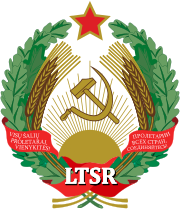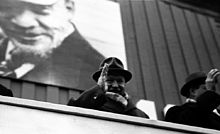Communist Party of Lithuania Lietuvos komunistų partija | |
|---|---|
 | |
| First Secretary | Mykolas Burokevičius (last) |
| Founded | 1 October 1918 |
| Banned | 1918–1940; 23 August 1991–present |
| Succeeded by | Democratic Labour Party of Lithuania Socialist People's Front |
| Headquarters | Vilnius |
| Newspaper | Tiesa |
| Ideology | |
| National affiliation | Communist Party of the Soviet Union (1940–1991) |
| International affiliation | Communist International (1919–1943) |
| Continental affiliation | UPC–CPSU |
| Colours | Red |
| Party flag | |
 | |

The Communist Party of Lithuania (Lithuanian: Lietuvos komunistų partija; Russian: Коммунистическая партия Литвы) is a communist party in Lithuania. The party was established in early October 1918 and operated clandestinely until it was legalized by Soviet authorities in 1940. The party was banned in August 1991, following the collapse of the Soviet Union and the dissolution of the Lithuanian SSR.
History
The party was working illegally until 1940. During the same year, the party amalgamated with the Communist Party of the Soviet Union (Bolsheviks). By the time of the formation of the Lithuanian SSR, the Communist Party of Lithuania (LKP) was headed by Antanas Sniečkus. In 1940, the LKP merged into the CPSU(b). The territorial organisation of the party in Lithuania was called Communist Party of Lithuania (bolshevik) (LK(b)P). In the Lithuanian territorial organisation, the first secretary of the Central Committee of the party (always a Lithuanian) was de facto governor of the country. The second secretary was always a Moscow-appointed Russian. In 1952 the name of the old Lithuanian party, LKP, was re-adopted.
On 24 December 1989,[1] during mass protests of the Singing Revolution against the Soviet Union in Lithuania, the party declared itself independent from Communist Party of the Soviet Union. By 1990, the main body of the CPL reorganized as the Democratic Labour Party of Lithuania, which in turn was later merged with Social Democratic Party of Lithuania under the latter's name; but with leadership dominated by ex-communists.
A small portion of the party remained loyal to the CPSU, and reorganized as the Communist Party of Lithuania ('on platform of Communist Party of the Soviet Union') under the leadership of Mykolas Burokevičius after the "traditional" party declared independence from its Soviet Union counterpart. The party played a major role in the January 1991 Events in Lithuania and initiating the creation of the National Salvation Committee. The Communist Party of Lithuania was eventually banned on 23 August 1991.[2] The party remains illegal in Lithuania, and is affiliated with the Union of Communist Parties — Communist Party of the Soviet Union (UCP-CPSU) headed by Gennady Zyuganov.
| Party membership[1] | |
|---|---|
| Year | Members |
| 1930 | 650 |
| 1936 | 1,942 |
| 1940 | 1,741 |
| 1941 | 4,620 |
| 1945 | 3,540 |
| 1950 | 27,800 |
| 1955 | 35,500 |
| 1960 | 54,300 |
| 1965 | 86,400 |
| 1970 | 116,600 |
| 1975 | 140,200 |
| 1980 | 165,800 |
First Secretaries of the Communist Party of Lithuania

| No. | Picture | Name
(Birth–Death) |
Took office | Left office | Political party |
|---|---|---|---|---|---|
| First Secretary | |||||
| 1 | 
|
Antanas Sniečkus
(1903–1974) |
21 July 1940 | 22 January 1974 | CPL/CPSU |
| — | 
|
Valerijus Charazovasacting
(1918–2013) |
22 January 1974 | 18 February 1974 | CPL/CPSU |
| 2 | Petras Griškevičius
(1924–1987) |
18 February 1974 | 14 November 1987 | CPL/CPSU | |
| — | 
|
Nikolajus Mitkinasacting
(1929–1998) |
14 November 1987 | 1 December 1987 | CPL/CPSU |
| 3 | 
|
Ringaudas Songaila
(1929–2019) |
1 December 1987 | 19 October 1988 | CPL/CPSU |
| 4 | 
|
Algirdas Brazauskas
(1932–2010) |
19 October 1988 | 23 December 1989 | CPL/CPSU |
| 23 December 1989 | 8 December 1990 | CPL (independent) | |||
| "Leading role" of the party abolished 7 December 1989 | |||||
| First Secretary (of pro-Moscow breakaway faction) | |||||
| 5 | 
|
Mykolas Burokevičius
(1927–2016) |
23 December 1989 | 23 August 1991 | CPL/CPSU |
Second Secretaries of the Communist Party of Lithuania
- Icikas Meskupas-Adomas 9 February 1941 – 13 March 1942
- Vladas Niunka April 1944 – 30 December 1944
- Alexander Isachenko 30 December 1944 – 24 November 1946
- Alexander Trofimov 24 November 1946 – 22 September 1952
- Vasily Aronov 25 September 1952 – 11 June 1953
- Motiejus Šumauskas February 1954 – 24 January 1956
- Boris Sharkov 28 January 1956 – 27 September 1961
- Boris Popov 30 September 1961 – 13 April 1967
- Valery Khazarov 13 April 1967 – 10 December 1978
- Nikolay Dubenko 11 December 1978 – 17 September 1986
- Nikolay Mitkin 17 September 1986 – 9 December 1988
- Vladimir Beryozov 9 December 1988 – 1990
Congresses of the Communist Party of Lithuania
| Congress | Date | Delegates
Voting + advisory |
Notes |
|---|---|---|---|
| 1st | 1–3 October 1918 | 34 | Took place illegally in Vilnius |
| 2nd | 4–6 March 1919 | 159 + 10 | Joint congress with the Communist Party of Byelorussia; Established the Communist Party (Bolsheviks) of Lithuania and Belorussia |
| 3rd | 24–29 October 1921 | 12 | Took place illegally in Königsberg |
| 4th | 17–21 July 1924 | 11 + 4 | Took place in Moscow; after the 5th World Congress of the Comintern |
| 5th | 5–9 February 1941 | 294 + 66 | Took place in Kaunas; First congress after establishment of the Lithuanian SSR |
| 6th | 15–18 February 1949 | 471 + 74 | First congress after World War II |
| 7th | 22–25 September 1952 | 517 + 75 | Elected 9 delegates to the 19th Congress of the Communist Party of the Soviet Union |
| 8th | 16–19 February 1954 | 541 + 44 | |
| 9th | 24–27 January 1956 | 578 + 101 | Elected 9 delegates to the 20th Congress of the Communist Party of the Soviet Union |
| 10th | 12–15 February 1958 | 572 + 108 | |
| 11th | 14–16 January 1959 | 596 + 126 | Elected 9 delegates to the 21st Congress of the Communist Party of the Soviet Union |
| 12th | 1–3 March 1960 | 593 + 103 | |
| 13th | 27–29 April 1961 | 688 + 119 | Elected 36 delegates to the 22nd Congress of the Communist Party of the Soviet Union |
| 14th | 9–10 January 1964 | 765 + 99 | |
| 15th | 3–5 March 1966 | 789 + 90 | Elected 42 delegates to the 23rd Congress of the Communist Party of the Soviet Union |
| 16th | 3–5 March 1966 | 748 + 47 | Elected 45 delegates to the 24th Congress of the Communist Party of the Soviet Union |
| 17th | 20–22 January 1976 | 904 | Elected 49 delegates to the 25th Congress of the Communist Party of the Soviet Union |
| 18th | 29–30 January 1981 | 933 | Elected 42 delegates to the 26th Congress of the Communist Party of the Soviet Union |
| 19th | 24–25 January 1986 | 947 | Elected 55 delegates to the 27th Congress of the Communist Party of the Soviet Union |
| 20th | 19 December 1989 | Voted to separate from the Communist Party of the Soviet Union |
See also
References
- ^ "24.12.1989". Tagesschau (Germany). Retrieved 29 December 2016.
- ^ Деятельность компартии Литвы под запретом
- ^ Motyl, Alexander J. (2000). Encyclopedia of Nationalism, Two-Volume Set. Elsevier. pp. 494–495. ISBN 0080545246.
| Central Committee |
| ||||||||||||||||||||||||||
|---|---|---|---|---|---|---|---|---|---|---|---|---|---|---|---|---|---|---|---|---|---|---|---|---|---|---|---|
| National meetings |
| ||||||||||||||||||||||||||
| Leadership sittings |
| ||||||||||||||||||||||||||
| Wider organisation |
| ||||||||||||||||||||||||||
| Groupings |
| ||||||||||||||||||||||||||
| See also |
| ||||||||||||||||||||||||||
| Parties in the Seimas |
|
|---|---|
| Other active parties | |
| Defunct parties (since 1990) |
|
| Defunct parties (inter-war) |
|
| International | |
|---|---|
| National | |
| Other | |